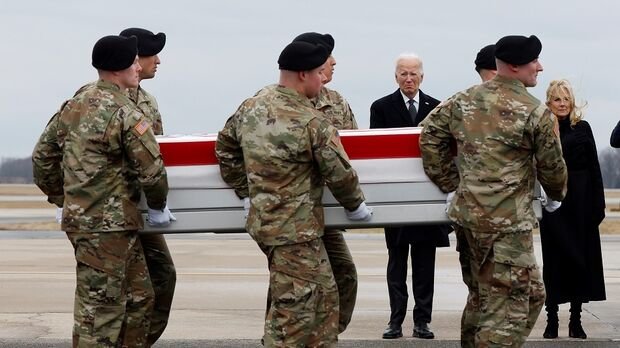In response to a drone attack in Jordan that claimed the lives of three U.S. soldiers, the United States executed a series of 85 airstrikes on Iran’s Islamic Revolutionary Guard Force and affiliated militias in Iraq and Syria. The strikes, conducted on Friday, utilized 125 precision munitions, targeting rockets, missiles, drones, and logistical systems employed by militias to attack U.S. and allied interests. According to U.S. Central Command, the operation aimed at facilities related to command and control, intelligence, and those connected to the recent attacks.
President Joe Biden emphasized in a statement that the United States does not seek conflict but issued a stern warning: “If you harm an American, we will respond.” The strikes, lasting approximately 30 minutes, focused on seven facilities – three in Iraq and four in Syria – carefully chosen to minimize civilian casualties based on evidence linking them to attacks on U.S. personnel.
John Kirby, White House spokesman for national security issues, stated that the Defense Department is in the early stages of assessing the damage, expressing confidence in the success of the strikes. The decision to conduct the airstrikes took into account factors such as weather conditions and timing to target militants effectively.
The drone attack in Jordan occurred along the Jordanian-Syrian border, resulting in the deaths of three U.S. Army reservists and numerous injuries. President Biden and other officials attributed the attack to Iranian-supplied militias, escalating tensions in the region. The recent U.S. strikes mark an escalation in a broader Middle East conflict, which has intensified since Hamas attacked Israel in October, resulting in significant casualties on both sides.
While U.S. officials are uncertain about the number of casualties among militants in the recent strikes, Lt. Gen. Douglas Sims, director of the Joint Staff, acknowledged the expectation of casualties among individuals inside the targeted facilities. President Biden and Defense Secretary Lloyd Austin hinted at the possibility of further actions, emphasizing that the response had commenced and would continue at the United States’ discretion.
The focus of the attacks was Iran’s Quds Force, an elite unit of the Islamic Revolutionary Guard Corps specializing in irregular warfare. The involvement of warplanes flown from the United States, including B-2 long-range stealth bombers, underscored the gravity of the operation.
Since October, Iran-backed militant groups have launched over 200 attacks across the Middle East, ranging from missile strikes in Yemen to assaults on bases housing U.S. troops in Iraq, Syria, and Jordan. The Pentagon has responded with occasional airstrikes, aiming to degrade the capabilities of these militias without escalating into a broader war.
Trita Parsi, executive vice president of the Quincy Institute for Responsible Statecraft, commented on Biden’s strategy, stating that it focuses on degrading militias’ capabilities rather than deterring them. Parsi emphasized the need for de-escalation in Gaza to address the broader regional tensions.
The recent drone attack in Jordan exposed vulnerabilities in U.S. defenses, prompting a shift in the conflict’s dynamics. The Pentagon maintains approximately 3,000 troops in Iraq, Syria, and Jordan to advise local forces in the fight against remnants of ISIS. Biden held Iran responsible for the soldiers’ deaths, citing their role in supplying weapons to the perpetrating militias.
A poll by the Defense Priorities think tank revealed that many Americans are unaware of the U.S. troop presence in Syria. Support for the troop presence diminished as the cost in American lives increased, and opinions on the Biden administration’s rationale for maintaining troops in the region varied.
As tensions continue to escalate, President Biden and Defense Secretary Austin have indicated the likelihood of further actions, underscoring the ongoing challenges in the volatile Middle East.
